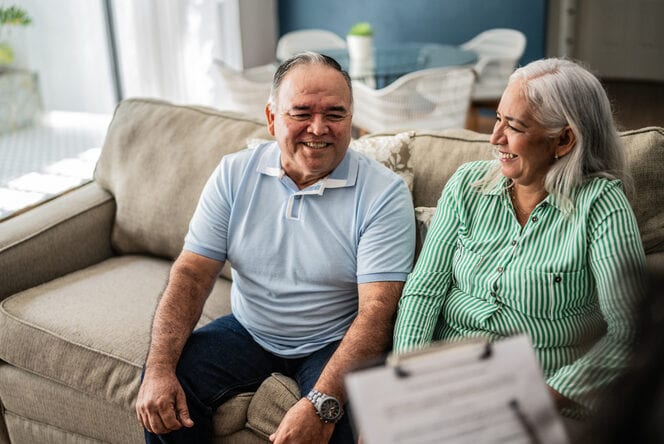In this article
Thanks to the growing popularity of luxury retirement communities, many of us may imagine an all-inclusive vacation for adults when we think about age-restricted senior housing. But if you think the biggest perk of 55-and-over communities is playing pickleball all day, think again.
“That is not most people’s reality,” says Allison Jaffe, a licensed real estate broker and certified seniors real estate specialist (SRES®) based in New Rochelle, New York. “For some seniors, they have worked hard for the money they have earned, and they want to enjoy it in these resort-style senior living communities. But for many, the choice to live in a 55-and-over community is based more on financial and support considerations than social considerations.”
So what exactly is a 55-and-over community and what does it offer? Here, experts explain the different types of age-restricted senior housing available across the country, plus the biggest pros and cons of living in a 50-and-over community for seniors and caregivers alike.
Key takeaways
- A 55-and-over community is age-restricted housing built to anticipate the specific accessibility and lifestyle needs of aging adults.
- There are three different types of 55-and-over communities in the U.S., including 55+ rental buildings, neighborhoods and active senior living communities.
- All 55-and-over communities feature community-based amenities which make it easier for seniors to pursue their unique interests and remain active.
What are 55-and-over communities, and who can live there?
A 55-and-over community is housing built to anticipate the accessibility needs of adults who are 55 years of age or older, Jaffe explains. Think single-story homes, elevators and wheelchair accessible spaces. They also are designed to offer lifestyle perks for seniors and empty nesters.
“Fifty-five-and-over communities are often sought out by older adults looking to downsize, simplify their lives by benefitting from a low-maintenance dwelling or looking to spend time with other adults at a similar life stage,” explains Kylie Meyer, gerontologist and assistant professor at the Frances Payne Bolton School of Nursing at Case Western Reserve University.
Read more:
Age-restricted housing comes in all shapes and sizes, depending mostly on location, according to Jaffe. “In the greater New York area, for example, the 55-and-over communities I’ve encountered are not the resorts or retirement communities like you’ll find in Florida which are cities within themselves,” Jaffe says. “These communities are more standard apartment buildings or neighborhoods that meet certain criteria in order to adopt a 55+ population.”
Specifically, all 55-and-over communities in the U.S. must meet criteria set by the Housing for Older Persons Act (HOPA) which maintains that at least 80% of occupied units are rented to someone who is 55 or older, whether they be houses, condos or apartments. As long as this ratio is held, younger family members are typically allowed to live in 55+ housing, too, but restrictions are determined on a case-by-case community basis, Jaffe says.
The different types of 55+ communities
Since the HOPA occupancy ratio is the only regulation a residential community must follow in order to legally restrict residency to seniors, there are multiple types of 55-and-over communities across the country. These are the main three, according to Jaffe:
- 55+ apartment buildings. Many standard urban apartment buildings are customized with senior living apartments that are compliant with Americans with Disabilities Act (ADA) accessibility standards. They also offer basic building offerings like maintenance services and on-site fitness rooms that support an easier yet active lifestyle.
- 55+ neighborhoods. Age-restricted suburban subdivisions or complexes feature smaller single family homes and often feature shared amenities like clubhouses, pools or parks. These neighborhoods are governed by a Homeowners Association (HOA), or an organization which handles community upkeep, including landscaping and housing maintenance, to cut down physical burdens for seniors.
- Active senior living communities. Similar to 55+ neighborhoods, active senior living communities feature HOA maintenance perks. But in addition, they offer an abundance of resort-style recreational amenities, including outdoor sports courts, wellness activities, restaurants, social clubs and more. Active senior living communities are typically found in parts of the country with mild weather year round, Jaffe notes.
“My father was in a 55-and-over community because it was the most affordable solution. It can be a great housing option for seniors who may not have many assets.”
— Allison Jaffe, seniors real estate specialist (SRES®)
Pros of living in a 55-and-over community
Housing features and amenities differ enormously from one type of age-restricted community to the next. But no matter what type of 55-and-over community you’re considering, these are the biggest benefits for seniors and caregivers to consider, according to experts:
1. Calm atmosphere.
With age-restrictions for residents comes less of the cacophony associated with young families and kids. “It’s typically a more quiet, accommodating and patient atmosphere,” Jaffe says. There can also be safety benefits with no kids around, which she noticed firsthand in her father’s 55+ rental building in Franklin Lakes, New Jersey. “If you are using a walker like he did, these buildings have less clutter in common spaces and no people running on the way to the elevator which can cause falls.”
2. Accessibility at a lower cost
Age-restricted senior living apartments can be a lifesaver for older seniors who cannot afford the cost of assisted living, Jaffe says, speaking from experience. “My father was in a 55-and-over community because it was the most affordable solution,” Jaffe says. “It can be a great housing option for seniors who may not have many assets since it still takes into account their physical needs.”
3. Low-maintenance living
In every type of 55-and-over community, shared spaces are kept up by a property manager or HOA. In addition, the majority handle exterior home maintenance, including things like yard work, repairs and even plowing sidewalks and driveways if you live in an area that gets extreme winter weather, Jaffe says.
4. Health and safety accommodations
Age-restricted communities tend to employ systems specifically designed to support seniors, whether by gating the premises or ensuring emergency personnel can reach its residents after hours. For example, in the 55+ rental building Jaffe’s father occupied, there was a master lockbox EMTs could access at any time to enter an apartment in the case a tenant could not let them in.
5. Flexible leases for rental properties
In a standard rental community, early lease termination comes with penalties. In a 55-and-over community, however, it’s common for tenants to be allowed to end a lease with 30-day notice in the event of a health crisis. This can save caregivers a significant amount of financial stress, Jaffe notes.
6. Convenient community-based amenities
Basic 55+ rental buildings offer on-site fitness rooms and shared communal gathering spaces which naturally support active aging. Active senior living communities are designed with even more chances for seniors to pursue their interests, whether it’s meeting new friends or exercising, by including additional resort-style amenities within walking distance.
“Fifty-five-and-over communities may be most suited for adults who are relatively independent, with few or no care needs.”
— Kylie Meyer, gerontologist
Potential drawbacks of 55+ communities
1. Property management fees
Seniors living in a 55-and-over community are required to pay extra fees associated with ensuring staff can properly maintain shared spaces, whether it’s to an HOA or property management company. The larger the community, the more you can expect to pay in added fees, according to experts.
2. HOA restrictions
Residents of any HOA-governed communities must abide by certain rules when it comes to modifying their home, Jaffe notes. These restrictions can be as subtle as not being allowed to plant certain types of flowers in the yard or as significant as not being allowed to build house additions like porches or pools.
3. Lack of diversity
To some, the combination of HOA and age restrictions can make 55-and-over communities feel a bit too homogenous or “cookie-cutter.” For seniors who prioritize the chance to meet different types of people, not just adults with similar backgrounds, ages and interests, these communities may not be the best fit, Jaffe says.
4. No on-site medical staff or support
In the event of a health emergency, 55-and-over communities do not keep skilled nurses on staff, nor are they outfitted with equipment that allow seniors to alert staff if they need assistance in their homes, Jaffe explains. “Because of this, 55-and-over communities may be most suited for adults who are relatively independent, with few or no care needs,” Meyer says.
5. Relocation is required to receive additional care
Unlike continuing care retirement communities, 55-and-over communities do not offer advanced care options. “For example, an older adult in independent living may move into assisted living if they need more help with daily tasks, or a skilled nursing facility if nursing care is required,” Meyer says. “But these next steps are not typically available in 55-and-over communities.”
How to know if a 55-and-over community is right for you
Seniors moving into a senior living community at the age of 55 may end up living there for decades, Jaffe says, emphasizing the importance of understanding what you’re buying into. Here, the experts spoke to offer their top tips for deciding if a 55-and-over community is a good fit:
- Consider your goals. “For example, if the goal is to engage more with others in a similar life phase, be sure to do your research about the types of activities available and how these are planned in the 55-and-over community you are considering,” Meyer says.
- Evaluate the cost, especially if the community requires residents to purchase their home. “Often older adults live in homes that are paid off or mostly paid off,” Meyer says. “Consider whether purchasing a new home or unit makes sense financially.”
- Be realistic about future care needs. “While none of us has a crystal ball, individuals with progressive chronic conditions may want to look at independent living options where it may be easier to access support when there’s a step up in care needs,” Meyer says.





